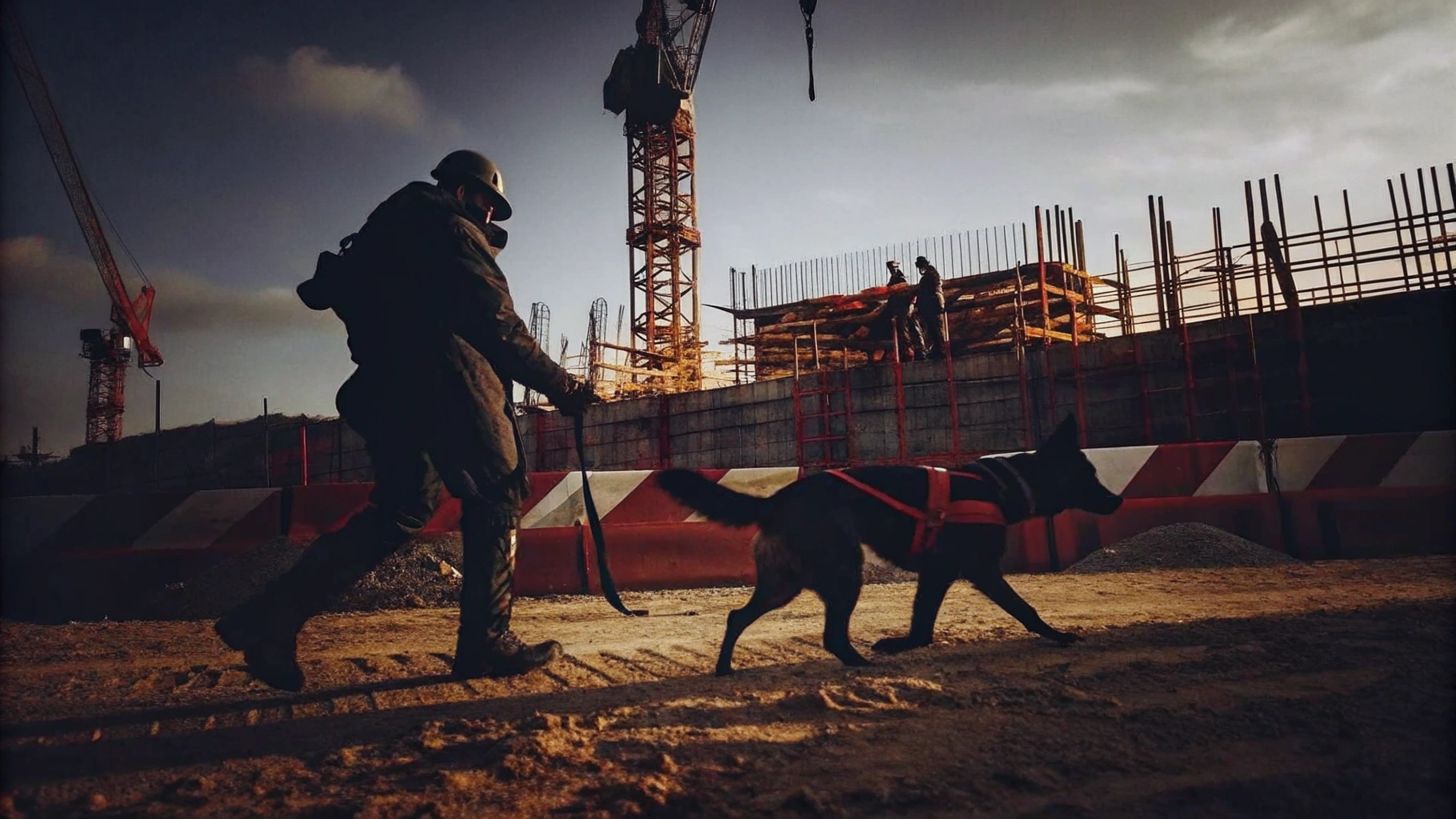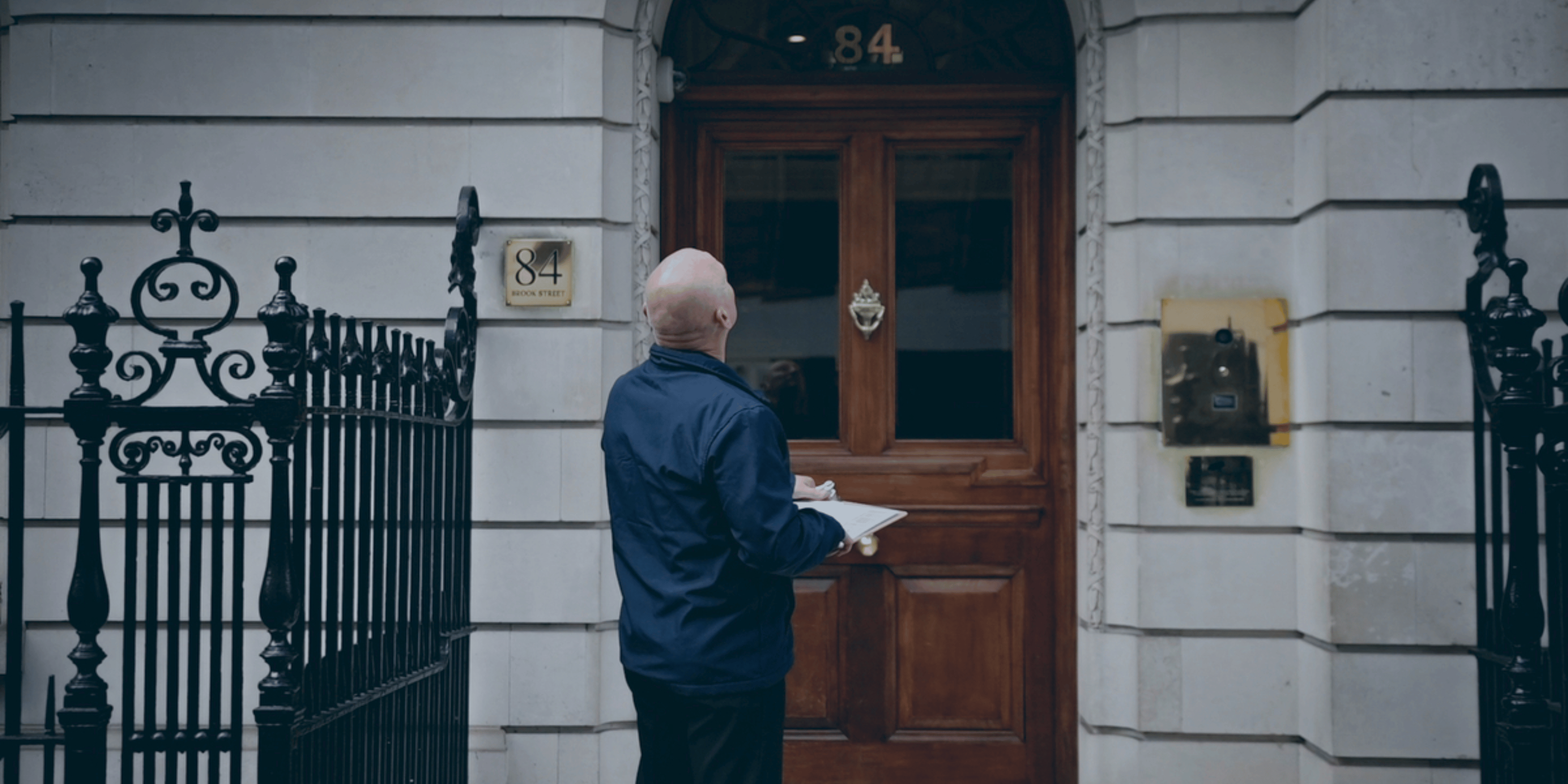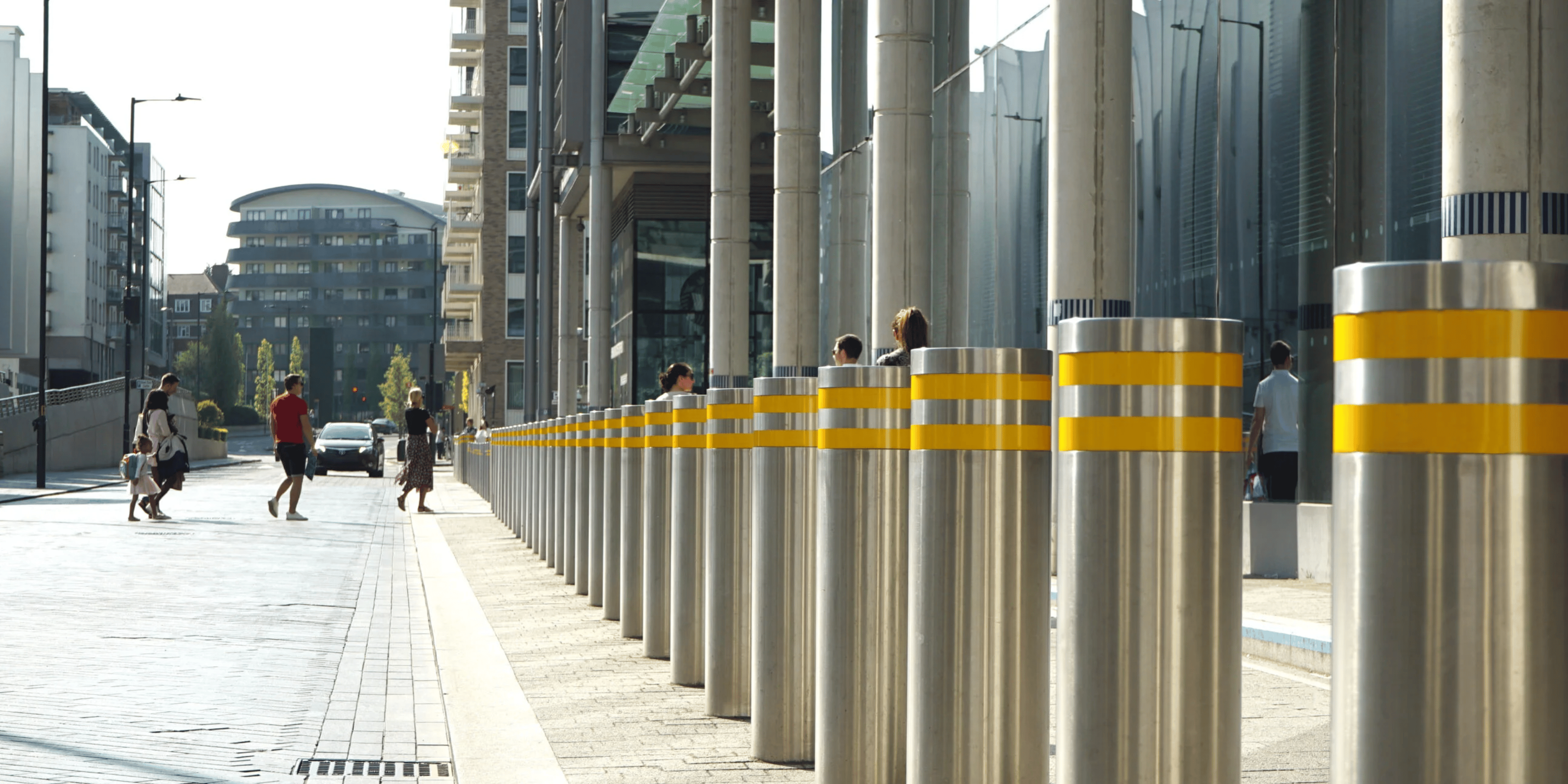
5 Steps to Implement Canine Security Services for Construction

Overview
The article presents five essential steps for implementing canine security services in construction:
- Assessing security needs
- Selecting a reputable provider
- Establishing operational protocols
- Managing the canine team
- Ensuring proper care for the dogs
Evidence indicates that trained dogs significantly enhance security effectiveness. This enhancement deters theft and vandalism, allowing construction personnel to concentrate on their tasks without safety concerns.
The reality is that security is a critical yet often underestimated business function. In practise, ignoring security risks can lead to substantial financial losses, operational disruptions, and reputational damage. For instance, construction theft costs UK businesses over £1m a week, highlighting the urgent need for effective security measures.
Priority First serves as a pragmatic solution, offering expertise in canine security that protects valuable assets. Their proven track record includes securing over £1.6bn in assets and ensuring rapid response times, reinforcing their role as a trusted partner in business resilience.
The lesson is clear: early investment in security not only prevents greater losses later but also ensures the continuity of operations. By prioritising security, businesses can focus on their core activities, confident in their protective measures.
Introduction
Canine security services are reshaping the construction site safety landscape, providing a distinctive combination of deterrence and detection that human guards alone cannot achieve. With their exceptional senses and training, these dogs not only detect potential threats but also establish a strong presence that deters criminal activity. As construction sites confront increasing risks of theft and vandalism, the pressing question emerges: how can project managers effectively incorporate canine security into their safety protocols to enhance protection and ensure peace of mind?
This guide delineates five essential steps for implementing canine security services, equipping construction teams with the necessary knowledge to protect their assets while maintaining operational efficiency.
Understand Canine Security Services and Their Role in Construction
Canine security services for construction employ specially trained dogs and handlers to enhance safety measures on construction sites. These canines excel at identifying intruders, deterring theft, and providing a strong physical presence that discourages criminal activity. Their acute senses enable them to detect potential threats that may escape human notice. In construction settings, where valuable equipment and materials are frequently left unattended, employing canine security services for construction can lead to a significant reduction in theft and vandalism incidents, with studies indicating a decrease of up to 25%. Furthermore, one dog patrol unit can be as effective as four non-dog patrols, ensuring comprehensive coverage of the area.
Integrating canine security services for construction into your security strategy not only enhances the safety of your assets but also fosters an environment where personnel can focus on their work without safety concerns. This proactive approach is vital for protecting construction investments and maintaining project timelines. Additionally, Priority First offers extensive access control and logistics management solutions that further enhance location safety. These services regulate the movement of personnel and vehicles, mitigating the risk of unauthorised access and operational disruptions.

Assess Your Construction Site's Security Needs
To effectively assess your construction site's security needs, consider the following essential steps:
-
Identify Assets: Begin by compiling a comprehensive list of all valuable assets on-site, including machinery, tools, and materials. Understanding what requires protection is fundamental, especially when theft in the construction industry costs businesses over £800 million annually in the UK.
-
Evaluate Risks: Conduct a thorough analyse of potential risks such as theft, vandalism, and unauthorised access. Consider elements like location, layout, and historical incidents, noting that 92% of construction areas encounter theft and vandalism. Priority First has effectively tackled these challenges through customised protective solutions, ensuring that sites remain safe and organised.
-
Consult Stakeholders: Engage with project managers, employees, and safety personnel to gather insights on perceived threats and vulnerabilities. Their firsthand experiences can provide valuable context for your assessment. Priority First emphasises collaboration with stakeholders to enhance protective measures effectively.
-
Determine Protection Levels: Based on the identified risks, establish the necessary level of canine protection. This includes deciding on the number of dogs, their training levels, and the frequency of patrols. Additionally, consider installing a two-metre fence as a physical barrier to improve site protection. Priority First offers comprehensive canine security services for construction that have proven effective in safeguarding valuable goods and ensuring operational efficiency, as demonstrated in various projects.
-
Document Findings: Create a detailed report summarising your assessment. This document will serve as a foundation for executing dog protection services efficiently, ensuring that all parties are informed and aligned on the protection strategy. By leveraging Priority First's expertise in conducting audits and risk evaluations, you can enhance safety tailored to your specific requirements.
Choose a Reputable Canine Security Provider
When selecting a canine security provider for construction sites, it is essential to evaluate the following criteria:
-
Experience and Reputation: Choose providers with a strong history in construction location protection. Investigate client testimonials and case studies that highlight successful partnerships; these can provide insights into the provider's reliability and effectiveness. Priority First has demonstrated its capability in overseeing safety for high-profile projects, such as the luxury hotel construction in Chelsea, where their canine security services for construction ensured a safe and organised site. Research indicates that 60% of intruders are deterred by the presence of a security dog, underscoring the importance of experienced providers of canine security services for construction in enhancing overall security.
-
Training and Certification: Confirm that both the canines and their handlers are certified and have undergone comprehensive training. This should include obedience, detection, and patrol training, ensuring that the dog units are well-prepared to handle the unique challenges of construction environments. As stated by Priority First, 'Canine security services for construction, which involve trained animal units, excel at identifying intruders,' highlighting the necessity of proper training and certification.
-
Insurance and Compliance: Ensure the provider has sufficient insurance coverage and complies with local regulations governing canine protection services. Compliance with the Guard Animals Act 1975, which mandates the presence of a qualified handler, is crucial for legal and operational integrity.
-
Customisation Options: Choose a provider that delivers personalised solutions to meet your particular safety requirements. This encompasses factors like the varieties of canines utilised and the frequency of patrols, enabling a strategy that aligns with your project needs. Priority First's strategic deployment of protection dogs, alongside their logistics management services, enhances overall project dynamics, making customisation essential for effective management of safety through canine security services for construction.
-
Support and Communication: Evaluate the provider's customer service and support framework. Efficient communication is essential for quickly tackling any safety issues, ensuring that your platform remains protected and functional without disruptions. Furthermore, one trained dog can substitute several human guards, demonstrating the efficiency and effectiveness of dog units in providing security, thereby strengthening the case for robust support and communication from the provider.
By concentrating on these criteria, construction managers can make informed decisions that improve safety and operational efficiency, ultimately aiding in the successful execution of their projects.

Establish Operational Protocols for Canine Units
To establish effective operational protocols for canine units, it is essential to adhere to the following guidelines:
-
Define Roles and Responsibilities: Clearly outlining the duties of handlers, protection personnel, and location managers regarding the dog units is crucial. This clarity promotes accountability and ensures that each team member comprehends their specific responsibilities, thereby enhancing overall effectiveness.
-
Develop Patrol Schedules: Creating a detailed timetable for dog patrols that encompasses all essential areas of the construction location is vital. Studies indicate that well-organised patrol timetables can significantly reduce safety violations, with sites utilising dog units experiencing approximately 25% fewer intrusions compared to those relying solely on human overseers. This statistic underscores the effectiveness of canine patrols in improving safety.
-
Implement Communication Procedures: Establishing robust communication protocols between handlers and protection personnel is necessary for the prompt reporting of incidents or suspicious activities. Effective communication is essential for quick responses to potential threats, enabling teams to act decisively. As noted by a security professional, "Clear communication between handlers and security teams is essential for effective operations, ensuring that everyone is on the same page during critical moments."
-
Conduct Regular Training: Arranging continuous training sessions for handlers and their animals is important to preserve their skills and adapt to any changes in the site environment. Ongoing training not only enhances the capabilities of the canine units but also reinforces the bond between handlers and their animals, which is crucial for successful collaboration. Furthermore, trained dogs play a vital role in detecting hazards, such as unstable structures and hazardous materials, which may not be easily observed by humans.
-
Monitor and Evaluate Performance: Regular assessments of the effectiveness of the dog units through performance reviews and feedback from personnel at the location are necessary. This assessment process allows for essential modifications, ensuring that the dog protection strategies remain efficient and aligned with the evolving needs of the construction area. Statistics suggest that incorporating canine security services for construction can lead to more efficient workflows and reduced downtime, ultimately supporting on-time project completions. Additionally, employing canine security services for construction can result in significant cost savings by performing the duties of multiple guards, making them a financially sound choice for construction site managers.
Manage and Care for Your Canine Security Team
Effectively managing and caring for your canine security team involves implementing best practices that are crucial for operational success:
-
Regular Health Checks: Routine veterinary examinations are essential to ensure that the animals remain healthy and fit for duty. Regular evaluations enable early detection of health concerns, thereby allowing the animals to perform at their best.
-
Nutrition and Exercise: A balanced diet tailored to the specific needs of working canines, combined with regular exercise, is vital. This combination is necessary for maintaining their physical condition and energy levels, enabling them to carry out security tasks effectively.
-
Training Reinforcement: Continuous reinforcement of training through regular practice sessions ensures that the canines remain alert and efficient in their duties, adapting to any changes in their working environment.
-
Create a Safe Environment: It is imperative to provide a secure and supportive working atmosphere for the animals. This includes proper shelter, rest areas, and minimizing exposure to potential hazards that could impact their health.
-
Handler Support: Handlers must be equipped with the necessary resources and support to perform their duties effectively. This includes ongoing training for both handlers and canines, as well as mental health resources to help them manage the demands of their roles.
The presence of trained canine security services for construction acts as a psychological deterrent, dissuading potential wrongdoers from committing crimes, particularly on construction sites. In the context of the ongoing Elephant & Castle regeneration project, which encompasses 24 projects valued at £4 billion, the significance of robust security measures—including canine security services for construction from Priority First—cannot be overstated.

Conclusion
Implementing canine security services for construction is a strategic move that significantly enhances site safety and asset protection. By utilising trained dogs and their handlers, construction managers can create a formidable deterrent against theft and vandalism, ensuring that valuable equipment and materials are safeguarded. This proactive security measure not only protects investments but also fosters a safer working environment, allowing personnel to focus on their tasks without the looming threat of crime.
The article outlines five essential steps for integrating canine security services into construction sites:
- Understanding the role of these services
- Assessing specific security needs
- Choosing a reputable provider
- Establishing operational protocols
- Managing the canine team effectively
Each step emphasises the importance of tailored security solutions, collaboration with stakeholders, and the necessity of ongoing training and support for both the canines and their handlers. Highlighting the impressive effectiveness of canine units, which can reduce incidents by up to 25%, underscores their value in maintaining operational efficiency and project timelines.
In conclusion, the incorporation of canine security services is not merely an enhancement but a vital component of modern construction site management. As the construction industry continues to evolve, embracing these innovative security solutions will lead to safer environments and ultimately more successful project outcomes. Construction managers are encouraged to take action now by assessing their security needs and exploring the benefits that a dedicated canine security team can bring to their operations.
Frequently Asked Questions
What are canine security services for construction?
Canine security services for construction involve specially trained dogs and handlers that enhance safety measures on construction sites by identifying intruders, deterring theft, and providing a strong physical presence to discourage criminal activity.
How do canine security services improve safety on construction sites?
These services improve safety by utilising dogs' acute senses to detect potential threats that may be missed by humans, leading to a significant reduction in theft and vandalism incidents, with studies indicating a decrease of up to 25%.
How effective are canine security units compared to non-dog patrols?
One dog patrol unit can be as effective as four non-dog patrols, ensuring comprehensive coverage of the area.
What additional services does Priority First offer to enhance construction site safety?
Priority First offers extensive access control and logistics management solutions that regulate the movement of personnel and vehicles, mitigating the risk of unauthorised access and operational disruptions.
What steps should be taken to assess a construction site's security needs?
To assess security needs, one should identify valuable assets, evaluate risks, consult stakeholders for insights, determine necessary protection levels, and document findings for effective execution of protection strategies.
Why is it important to identify assets on a construction site?
Identifying assets is fundamental to understanding what requires protection, especially since theft in the construction industry costs businesses over £800 million annually in the UK.
What should be considered when evaluating risks on a construction site?
Consider potential risks such as theft, vandalism, and unauthorised access, along with factors like location, layout, and historical incidents.
How can stakeholder consultation enhance security assessments?
Engaging with project managers, employees, and safety personnel provides valuable context and insights on perceived threats and vulnerabilities, improving protective measures.
What factors determine the level of canine protection needed?
The necessary level of canine protection is determined by the identified risks, including the number of dogs, their training levels, and the frequency of patrols.
What is the purpose of documenting findings from a security assessment?
Documenting findings creates a detailed report that serves as a foundation for executing dog protection services efficiently, ensuring all parties are informed and aligned on the protection strategy.




